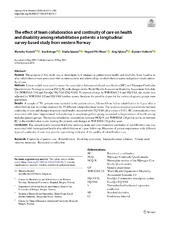| dc.contributor.author | Hustoft, Merethe | en_US |
| dc.contributor.author | Biringer, Eva Aaker | en_US |
| dc.contributor.author | Gjesdal, Sturla | en_US |
| dc.contributor.author | Moen, Vegard Pihl | en_US |
| dc.contributor.author | Assmus, Jörg | en_US |
| dc.contributor.author | Hetlevik, Øystein | en_US |
| dc.date.accessioned | 2020-05-18T08:17:45Z | |
| dc.date.available | 2020-05-18T08:17:45Z | |
| dc.date.issued | 2019 | |
| dc.Published | Hustoft M, Biringer EA, Gjesdal S, Moen VP, Assmus J, Hetlevik Ø. The effect of team collaboration and continuity of care on health and disability among rehabilitation patients: a longitudinal survey-based study from western Norway. Quality of Life Research. 2019:1-13 | eng |
| dc.identifier.issn | 1573-2649 | |
| dc.identifier.issn | 0962-9343 | |
| dc.identifier.uri | https://hdl.handle.net/1956/22291 | |
| dc.description.abstract | Purpose: The purpose of this study was to investigate how changes in patient-rated health and disability from baseline to after rehabilitation were associated with communication and relationships in rehabilitation teams and patient-rated continuity of care. Methods: Linear models were used to assess the associations between relational coordination [RC] and Nijmegen Continuity Questionnaire-Norwegian version [NCQ-N] with changes in the World Health Association Disability Assessment Schedule 2.0 [WHODAS 2.0] and EuroQol EQ-VAS [EQ-VAS]. To express change in WHODAS 2.0 and EQ-VAS, the model was adjusted for WHODAS 2.0 and EQ-VAS baseline scores. Analyses for possible slopes for the various diagnosis groups were performed. Results: A sample of 701 patients were included in the patient cohort, followed from before rehabilitation to 1 year after a rehabilitation stay involving treatment by 15 different interprofessional teams. The analyses revealed associations between continuity of care and changes in patient-rated health, measured with EQ-VAS (all p values < 0.01). RC communication was associated with more improvement in functioning in neoplasms patient group, compared to improvement of health among included patient groups. The results revealed no associations between NCQ-N and WHODAS 2.0 global score, or between RC in the rehabilitation teams treating the patients and changes in WHODAS 2.0 global score. Conclusion: The current results revealed that better personal, team and cross-boundary continuity of rehabilitation care was associated with better patient health after rehabilitation at 1-year follow-up. Measures of patient experiences with different types of continuity of care may provide a promising indicator of the quality of rehabilitation care. | en_US |
| dc.language.iso | eng | eng |
| dc.publisher | Springer | eng |
| dc.rights | Attribution CC BY | eng |
| dc.rights.uri | http://creativecommons.org/licenses/by/4.0 | eng |
| dc.title | The effect of team collaboration and continuity of care on health and disability among rehabilitation patients: a longitudinal survey-based study from western Norway | en_US |
| dc.type | Peer reviewed | |
| dc.type | Journal article | |
| dc.date.updated | 2020-01-31T08:07:43Z | |
| dc.description.version | publishedVersion | en_US |
| dc.rights.holder | Copyright 2019 The Author(s) | |
| dc.identifier.doi | https://doi.org/10.1007/s11136-019-02216-7 | |
| dc.identifier.cristin | 1713281 | |
| dc.source.journal | Quality of Life Research | |

